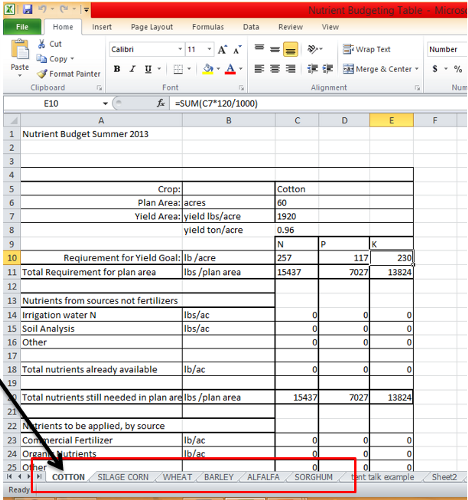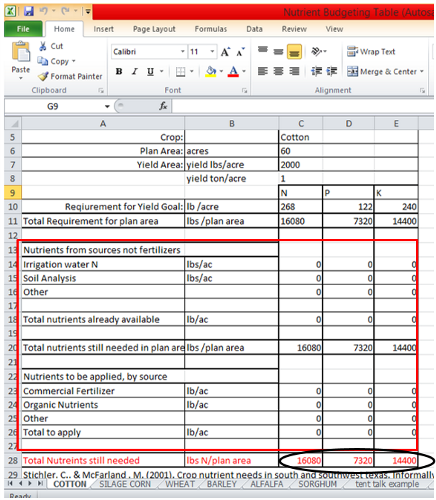The Nutrient Budget Tool is a resource for growers who are interested in adequately providing the correct amount of nutrients for their crops for the optimal yields. This tool allows growers to choose crop type and yield goals into a spreadsheet that will then output the needed fertilizer levels of N, P, K needed to meet projected yield goals. Soil test, irrigation water test, and manure nutrient test analysis results can also be input to calculate the overall results of a crop’s nutrient/fertilizer needs. This tool is designed to help promote soil testing and analysis and to help growers be more cost and nutrient efficient. We plan to expand the Nutrient Budget Tool in the future to incorporate soil salinity levels (EC) and pH to better service the nutrient budget users and provide greater information.
Download:
1. Choose the crop from the list of tabs at the bottom of the screen.

2. Fill in the “Plan Area” field in acres and “Yield Area” field in lbs/acre or tons/acre. Doing this will provide the needed N, P, and K requirements of the specified plan area.

3. Additional numbers from irrigation water analysis, soil analysis and fertilizer analysis from a plan area can be input to factor in to the overall needed requirements for N, P, and K in lbs/plan area.

Fertilization will vastly improve pasture production. The first post-seeding fertilization should be delayed until the seeded pasture species are growing vigorously and can compete with the weeds. Then, take care to graze off all the forage produced, or mow the pasture periodically so that coarse material of low nutritive value does not accumulate.
Applications of nitrogen to legumes do not produce economic returns. Applications of nitrogen will reduce the activity of the Rhizobium associated with legumes reducing the amount of free nitrogen that is fixed. Grasses, however, respond well to applications of nitrogen when adequate irrigation water is supplied.
Vigorous, dark green plants associated with livestock urine spots indicate the soil is deficient in nitrogen. However, excessive rates of nitrogen fertilization may result in pasture forage containing toxic amounts of nitrate nitrogen. Do not use the pasture during the 2 or 3 week period after heavy fertilization with nitrogen because of risks associated with nitrate poisoning.
Yield of legumes grown on many Arizona soils is increased by phosphate application. The phosphate requirement for several years may be applied at the time of seeding. When this is done, phosphate is worked into the soil during seedbed preparation. Phosphate may also be applied after stand establishment by broadcasting on the surface of the soil when this operation will not interfere with the pasture management program. Phosphate does not move readily from the point of contact with soil in calcareous soils, so it must be incorporated into the soil to be most effective.
Fertilizer application can influence the make-up of the stand when mixtures of grasses and legumes have been planted. Phosphate favors legumes: nitrogen favors grasses. Fertilizer applications can be made to keep the ratio of legume to grass plants desired.
Generally, potassium applications have failed to increase the yield of crops in Arizona. However, there may be specific locations where applications of potassium may increase dry matter yield and the percent of potassium in forage.
Deficiency Symptoms
Nitrogen deficiency in alfalfa occurs as a result of poor nodulation or inefficient nitrogen fixation due to molybdenum deficiency. Nitrogen-deficienct plants are dwarfed, spindly, and generally yellow. A pink color develops in the petioles and midrib of the oldes leaves. The oldest turn yellow and die and the symptoms progress upward to younger leaves.
Sources
Sources of nitrogen for growth of alfalfa include that supplied by atmospheric fixation, mineralization of organic matter, release from soil minerals, irrigation water, fertilizer, and crop residues, manures, or waste products. The earth's atmosphere contains about 78 percent nitrogen gas which can be converted to usable forms by free-living organisms in the soil, organisms living in a symbiotic relationship with plants and by lightning. Alfalfa obtains an estimated on-half to three-quarters of its nitrogen through symbiotic nitrogen fixation. Thunderstorms in Arizona can contribute a few pounds of nitrogen per acre per year. Fixation by free-living organisms in the soil is thought to be a minor source of nitrogen. Most soils in Arizona contain less than 1 percent organic matter, and release of nitrogen from organic mater is minor. The exact contribution of nitrogen released from soil minerals is uncertain, but is probably of minor importance. Nitrogen added in the irrigation water can be substantial. For example, if the nitrate-N content of the irrigation water is 5 ppm and 8 acre-feet/acre of water are applied, 110 pounds of nitrogen per acre is also applied. Fertilizers are a major source of nitrogen, even in the case of some phosphorus. For example ammonium phosphate (11-52-0) applied at a rate of 300 pounds of P205 per acre will add 63 pounds of nitrogen per acre.
Deficiency symptoms
Potassium Deficiency symptoms appear first as small white spots on the outer edges of the upper leaflets. The areas between the spots may turn yellow and a brown necrosis may develop around the margins. In severe cases, the size and number of white spots increases and the leaves become yellow and dry. The lower leaves may drop. Some alfalfa varieties exhibit a genetic disorder resulting in white sports over the entire leaf surface, in contrast to the margins as in potassium deficiency.
Potassium deficiency symptoms may also appear on older leaves as poorly defined gray spots on the upper surface near the edges opposite the midrib. These areas become pinkish cinnamon in color, and spread across the entire leaf. Secondary shoots with small leaves may continue to be produced from the base of the plant.
Fertilization
Alfalfa has very high potassium requirements. Alfalfa removes approximately 60 pounds of K2O per acre per ton of hay yield. However, potassium fertilization of calcareous soils in Arizona is generally not required. Native levels of potassium in the soil are usually high enough to satisfy crop needs. Potassium may be needed on certain noncalcareous sandy soils of low cation exchange capacity. Ensuring an adequate level of potassium is very important in attempting to maintain alfalfa in alfalfa-grass mixtures since grasses can outcompete alfalfa for potassium.
Deficiency Symptoms
Phosphorus deficiency does not always produce well-defined symptoms in alfalfa, and growth reduction may occur without obvious deficiency symptoms. When symptoms do occur, phosphorus deficiency in alfalfa is characterized by stunted and barren plats. Leaves may be small and appear abnormally dark or bluish-green in color. The leaflets may fold together and the underside of the leaf may develop a purplish color. The oldest leaves may turn yellow and die.
One of the first symptoms of phosphorus deficiency is reduced respiration, which results in accumulation of carbohydrates. Corbohydrate accumulation contributes to the dark-green color of phosphorus deficient plants, and leads to accumulation of anthocynanin pigments, which are responsible for purpling associated with phosphorus deficiency. Leaf hoppers and three-cornered tree hoppers also can be responsible for purpling in alfalfa. Phosphorus is mobile in the plant, and highest concentrations may be remobilized from the oldest to the youngest leaves during deficiency conditions leading to death of the older leaves.
Fertilization
Soil and plant analyses serve as a guide for phosphorus fertilizer requirements. Soil samples should be taken randomly form fields or management units before planting and submitted to a laboratory for analysis. Soil test values >15, 11 to 15, 6 to 10, and < 6 ppm P from a bicorbonate extraction correspond to high, medium, low, and very low levels of P in the soil, and require none, 50 to 150, 140 to 250, and 200 to 300 pounds of P2O5 to be applied, respectively, for a 3-year crop. After planting, the phosphorus status of the field can be monitored by sampling stems at 10 percent bloom, except during the hot summer months. Total phosphorus concentrations in the plant greater than 0.20 percent indicate that top-dressing of phosphorus fertilizer is not required. A phosphorus rate of 50 to 100 pounds P2O5 per acre is recommended if the plant phosphorus concentration is 0.18 percent to 0.20 percent, 75 to 150 pounds P2O5 per acre is recommended if the plant phosphorus concentration is 0.14 percent to 0.18 percent, and 100 to 200 pounds P2)5 per acre is recommended if the plant phosphorus concentration is less than 0.14 percent.